Business rates and 'reasonable repair'

|
| The above photograph is indicative and does not relate to the case described below. |
The case of Newbigin (Valuation Officer) v SJ &J Monk (a firm) (2017) concerned the issues of business rates and 'reasonable repair'.
The dispute between a property owner and the local rating office confirmed the principle that if a property is not in a reasonable state of repair, it is to be valued as it is, not as it ‘should be’, or as the Supreme Court put it:
'Does a commercial building which is in the course of redevelopment have to be valued for the purposes of rating as if it were still a useable office?'
The property concerned was an office building which was in the course of being renovated. When the rateable value was being assessed in January 2012, the premises were vacant and a great deal of the flooring, ceilings, lighting and other fittings had been removed.
The owners' agent suggested to the local valuation officer (LVO) that the rateable value should be reduced from £102,000 to £1, because the premises could not be occupied. The LVO refused, citing legislation which required the LVO to assume a property is in 'reasonable repair' for valuation purposes.
The dispute matter was referred to the Valuation Tribunal, which sided with the property owner, holding that the condition of the building precluded the conclusion that it was in reasonable repair.
In considering the arguments, the Court gave weight to the 'reality principle', which establishes that 'the property must be valued as it exists at the relevant date'. Accordingly, the presumption that it was in reasonable repair could not stand.
The decision overturned a decision by the Court of Appeal which had cast doubt on the applicability of the ‘reality principle’. It will come as a considerable relief to property developers who are refurbishing properties.
[edit] Related articles on Designing Buildings Wiki
Featured articles and news
One of the most impressive Victorian architects. Book review.
Common Assessment Standard now with building safety
New CAS update now includes building safety questions as mandatory.
RTPI leader to become new CIOB Chief Executive Officer
Dr Victoria Hills MRTPI, FICE to take over after Caroline Gumble’s departure.
Social and affordable housing, a long term plan for delivery
The “Delivering a Decade of Renewal for Social and Affordable Housing” strategy sets out future path.
A change to adoptive architecture
Effects of global weather warming on architectural detailing, material choice and human interaction.
The proposed publicly owned and backed subsidiary of Homes England, to facilitate new homes.
How big is the problem and what can we do to mitigate the effects?
Overheating guidance and tools for building designers
A number of cool guides to help with the heat.
The UK's Modern Industrial Strategy: A 10 year plan
Previous consultation criticism, current key elements and general support with some persisting reservations.
Building Safety Regulator reforms
New roles, new staff and a new fast track service pave the way for a single construction regulator.
Architectural Technologist CPDs and Communications
CIAT CPD… and how you can do it!
Cooling centres and cool spaces
Managing extreme heat in cities by directing the public to places for heat stress relief and water sources.
Winter gardens: A brief history and warm variations
Extending the season with glass in different forms and terms.
Restoring Great Yarmouth's Winter Gardens
Transforming one of the least sustainable constructions imaginable.
Construction Skills Mission Board launch sector drive
Newly formed government and industry collaboration set strategy for recruiting an additional 100,000 construction workers a year.
New Architects Code comes into effect in September 2025
ARB Architects Code of Conduct and Practice available with ongoing consultation regarding guidance.
Welsh Skills Body (Medr) launches ambitious plan
The new skills body brings together funding and regulation of tertiary education and research for the devolved nation.
Paul Gandy FCIOB announced as next CIOB President
Former Tilbury Douglas CEO takes helm.
























